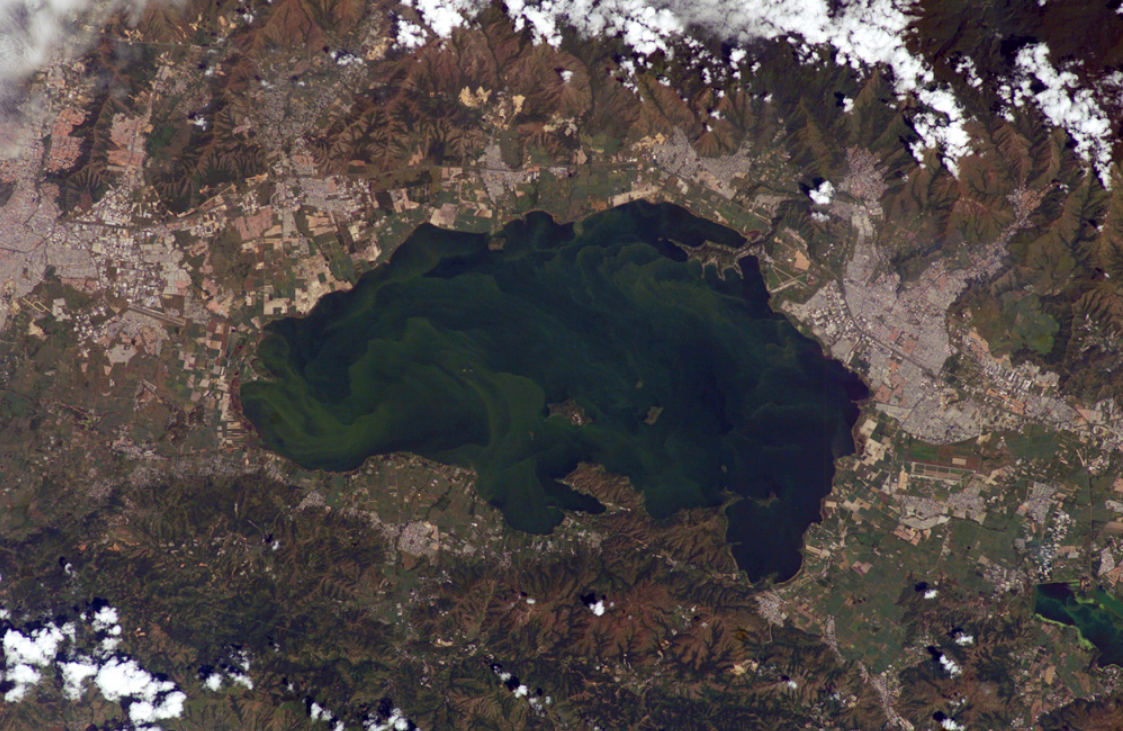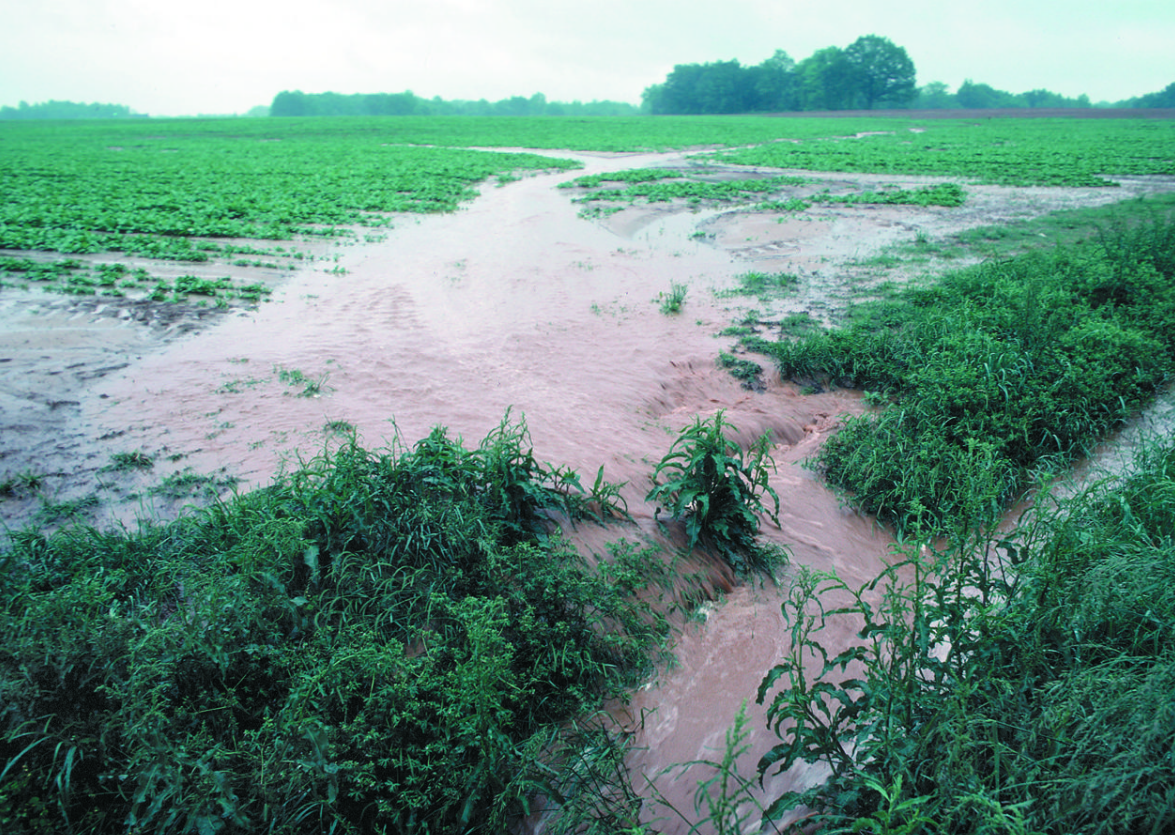Cultural eutrophication is when a flux of excess nutrients from human activity are added into a local run-off which in turns speeds up the natural eutrophication. This is caused by human activity. The problem became apparent once the green revolution and industrial revolution began in the last century. Phosphates and nitrates are the two main nutrients that cause cultural eutrophication as they enrich the water, allowing for aquatic plants such as algae to grow rapidly. Algae is prone to blooming into large quantities removing oxygen from the water generating anoxic conditions. This anoxic environment kills off any organisms in the water body and make it hard for terrestrial animals to gain access to the water for drinking. Increased competition for the added nutrients can cause potential disruption to entire ecosystems and food webs, as well as a loss of habitat and biodiversity of species. There are many ways in which nutrients are added through human activity, including, but not limited to: waste treatment plants, golf courses, fertilizing lawns, burning of fossil fuels and agricultural practices. Cultural eutrophication can occur in fresh water and salt water bodies, usually shallow waters are the most susceptible. In shallow lakes, sediments are frequently disturbed by wind-wave and resuspended, which result in huge nutrients release to overlying water As well the shallow areas are normally where the run-off reaches first and has less water to dilute the excess nutrients. This begins to cause many problems for the nearby wildlife as well as recreational activities for humans. Eutrophication restricts water use for fisheries, recreation, industry and drinking because of increased growth of undesirable algae and aquatic weeds and the oxygen shortages caused by their death and decomposition.
- cultural eutrophication
- fossil fuels
- fertilizing
1. Effects
One response to added amounts of nutrients in the aquatic ecosystem is the rapid growth of microscopic algae, also known as an algal bloom. In freshwater systems, the formation of floating algal blooms are commonly nitrogen-fixing cyanobacteria (blue-green algae). This outcome is favored when nitrogen inputs are reduced and phosphorus inputs are increased.[1] Large amounts of algae reduce the amount of dissolved oxygen available in the water for other organisms, which increases fish mortality rates. Nutrient pollution is a major cause of algal blooming, however, the excess nutrients also facilitate the growth of other aquatic plants. Following this, overcrowding occurs and plants compete for sunlight, space, and oxygen. Overgrowth of water plants also blocks sunlight and oxygen for aquatic life in the water, which threatens their survival. Increased competition for the added nutrients can cause potential disruption to entire ecosystems and food webs, as well as a loss of habitat, and biodiversity of species.[2]
2. Research
The Experimental Lakes Area (ELA) that spans from Michigan, USA to Ontario, Canada is a fully equipped, year-round, permanent field station that uses the whole ecosystem approach and long-term, whole-lake investigations of freshwater focusing on cultural eutrophication. ELA is currently cosponsored by the Canadian Departments of Environment and Fisheries and Oceans, with a mandate to investigate the aquatic effects of a wide variety of stresses on lakes and their catchments.[3][4]
3. Sources of Anthropogenic Pollution
3.1. Raw Sewage

Raw sewage is a large contributor to cultural eutrophication since sewage matter is very rich in nutrients. Releasing raw sewage into a large water body is referred to as sewage dumping, which is a large problem in today's society even in developed countries. There are multiple different ways to fix cultural eutrophication with raw sewage being a point source of pollution. Waste collection, incineration, and waste treatment have become common practices in industrialized parts of the world.[5] A wastewater treatment plant is where the water will be filtered to regular water before discharging back into a large water body. In some areas incineration is used where the solid waste is exposed to high temperatures turning the waste into ash. Convectional sludge incineration systems mostly charge dewatered sludge directly into the incinerator.[6] Generating an anaerobic environment is also another method where microorganisms degrade the waste without the use of oxygen. An anaerobic system can be used for pretreatment prior to discharging to a municipal wastewater treatment plant.[7] The incineration method and the anaerobic methods are the most environmentally friendly compared to others.[5] Anaerobic treatment use substantially less energy, require less chemicals, and incur lower sludge handling costs compared to aerobic treatments; as well the biogas produced is a source of renewable energy to generate electricity.[7] Similarly, incinerating a ton of waste produces electric energy equivalent to 52.1 kWh/ton of combustible waste in the combines heat and power generation; this amount displaces electricity that would be provided by an electric utility power plant that uses fossil fuels in Korea.[5]
3.2. Agriculture

Since the agricultural boom in the 1910s and again in the 1940s to match the increase in food demand, agricultural production relies heavily on the use of fertilizers.[5] Fertilizer is a natural or chemically modified substance that helps soil become more fertile. These fertilizers contain high amounts of phosphorus and nitrogen, which results in excess amounts of nutrients entering the soil. Nitrogen, phosphorus and potassium are the "Big 3" primary nutrients in commercial fertilizers, each of these fundamental nutrients play a key role in plant nutrition.[8] When nitrogen and phosphorus are not fully utilized by the growing plants, they can be lost from the farm fields and negatively impact air and downstream water quality.[9] These nutrients can eventually end up in aquatic ecosystems and are a contributor to increased eutrophication.[10] When farmers spread their fertilizer whether it is organic or synthetically made most of the fertilizer will turn into runoff that collects downstream generating cultural eutrophication.
There are many ways to help fix cultural eutrophication caused by agriculture. Safe farming practices is the number one way to fix the problem. Some safety precautions are:
- Nutrient Management Techniques - Anyone using fertilizers should apply fertilizer in the correct amount, at the right time of year, with the right method and placement.[9]
- Year - Round Ground Cover - a cover crop will prevent periods of bare ground thus eliminating erosion and runoff of nutrients even after the growing season has occurred.[9]
- Planting Field Buffers - By planting trees, shrubs and grasses along the edges of fields to help catch the runoff and absorb some nutrients before the water makes it to a nearby water body.[9]
- Conversation Tillage - By reducing frequency and intensity of tilling the land will enhance the chance of nutrients absorbing into the ground.[9]
The content is sourced from: https://handwiki.org/wiki/Earth:Cultural_eutrophication
References
- Schindler, David W.; Hecky, R.E.; Findlay, D.L.; Stainton, M.P.; Parker, B.R.; Paterson, M.J.; Beaty, K.G.; Lyng, M. et al. (August 2008). "Eutrophication of lakes cannot be controlled by reducing nitrogen input: Results of a 37-year whole-ecosystem experiment". Proceedings of the National Academy of Sciences of the United States of America 105 (32): 11254–11258. doi:10.1073/pnas.0805108105. PMID 18667696. http://www.pubmedcentral.nih.gov/articlerender.fcgi?tool=pmcentrez&artid=2491484
- Rabalais, NN (Mar 2002). "Nitrogen in aquatic ecosystems". AMBIO: A Journal of the Human Environment 31 (2): 102–112. doi:10.1579/0044-7447-31.2.102. PMID 12077998. https://dx.doi.org/10.1579%2F0044-7447-31.2.102
- Schindler, David William (2009). "A personal history of the Experimental Lakes Project". Canadian Journal of Fisheries and Aquatic Sciences 66 (11): 1837–1847. doi:10.1139/f09-134. http://article.pubs.nrc-cnrc.gc.ca/RPAS/rpv?hm=HInit&journal=cjfas&volume=66&calyLang=eng&afpf=f09-134.pdf.
- Schindler, David W., Vallentyne, John R. (2008). The Algal Bowl: Overfertilization of the World's Freshwaters and Estuaries, University of Alberta Press, ISBN:0-88864-484-1.
- Seo Seongwon; Aramaki Toshiya; Hwang Yongwoo; Hanaki Keisuke (2004-01-01). "Environmental Impact of Solid Waste Treatment Methods in Korea". Journal of Environmental Engineering 130 (1): 81–89. doi:10.1061/(ASCE)0733-9372(2004)130:1(81). https://dx.doi.org/10.1061%2F%28ASCE%290733-9372%282004%29130%3A1%2881%29
- "Incinerating Sewage Sludge and producing reusable ash: Japanese Experience.". http://www.seas.columbia.edu/earth/wtert/sofos/nawtec/1990-National-Waste-Processing-Conference/1990-National-Waste-Processing-Conference-05.pdf.
- "Anaerobic Wastewater Treatment". https://www.evoqua.com/en/brands/adi-systems/Pages/anaerobic-treatment.aspx.
- "Fertilizer 101: The Big Three - Nitrogen, Phosphorus and Potassium.". 2014-05-07. https://www.tfi.org/the-feed/fertilizer-101-big-3-nitrogen-phosphorus-and-potassium.
- "The Sources and Solutions: Agriculture". 2013-03-12. https://www.epa.gov/nutrientpollution/sources-and-solutions-agriculture.
- Huang, Jing; Xu, Chang-chun; Ridoutt, Bradley; Wang, Xue-chun; Ren, Pin-an (August 2017). "Nitrogen and phosphorus losses and eutrophication potential associated with fertilizer application to cropland in China". Journal of Cleaner Production 159: 171–179. doi:10.1016/j.jclepro.2017.05.008. https://dx.doi.org/10.1016%2Fj.jclepro.2017.05.008
